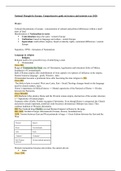National Thought In Europe: Comprehensive guide on lectures and tutorials year 2020
Week 1
Cultural discontinuity of europe - concentration of cultural and political differences within a small
mass of land.
Manifestation of Nationalism in states:
Centralization: stays the same / western Europe
Unification: based on language and culture / central Europe
Separatism: multi-ethnic empires, based on identity rights, communal differences / eastern
Europe
Napoleon->WWI - formation of Nationalism
Language & religion
Religion
Religion used to be a powerful way of identifying a state
Christendom
Circa 300:
Reign of Constantine the Great: rise of Christianity, legalization and toleration (Edict of Milan),
foundation of Constantinople.
Split of Roman empire after establishment of twin capitals: two spheres of influence in the empire,
Eastern business language - greek, Western - latin.
Christendom becomes a prominent force after becoming the state religion in 380.
Circa 400:
The bible in latin is created. West uses Latin, East - Greek.Theology changes based on the language
used for church matters, mass.
Rome’s importance in biblical history => Mental superiority of the Patriarch of Rome => Rivalry
between the Patriarchs
Circa 500-600:
476: Barbaric tribes destroy Rome and the Western roman empire, destruction of the secular structure.
(=> Superiority of Eastern pope)
Germanic tribes (Goths, Franks) recognize Christianity. Even though Rome is conquered, the Church
and priests remain important, pontifical order becomes christianized. Bishops stay intact. They
continue tradition of Western christianity.
800:The Frankish king Charles crowned Roman Emperor in Rome by the pope.
800-1000: Northern Europe christianized (Frisians, Saxons, Scandinavians)
1054: Tension between East and West patriarchs is huge => Great Schism between the East and the
West
Western Eastern
Rome Constantinople
Latin Greek
“Catholic” “Orthodox”
Sole Western Various multiple patriarchs
patriarch
Western monasteries become universities, the eastern do not.
Islam
Circa 1200:
, An enormous Islamic presence in Europe.
Spread: Saudi Arabia -> North Africa -> Across Gibraltar -> Europe -> towards France
First usage of the word “Europeans”: used after a conflict with Islamic invaders. Confrontation with
islam defined a sense of religious identity in europe. Reconquista in Spain (720-1492)
Other religions than Christianity are banned in Spain - an alignment between state and religion.
Inquisition (1478-1834) is established to ensure this => Spain becomes the first totalitarian state in
Europe.
As spaniards drive islam out of the West, they come back from the East =>Islam isolation of the
Constantinople (Islam Balkans), island of Christianity => Fall of Constantinople (weakened after the
crusades in 1100-1200)(1453) =>Islam Ottoman Empire
State of war in Europe:. Constant threats were a force of concentration to consolidate state power in
the West.
Christianity (again)
Circa 1500:
Europe is no longer interested in Mediterranean, Atlantic ocean is much more interesting for
merchants and trade.
Ottoman empire becomes a challenge for the Christian world (especially the Habsburg Empire).
Theological differences in Western Europe lead to Reformation.
Lutheran Reformation (1517): Luther is lucky: 1. his ideas come after the printing press -
ideas spread faster 2. King Charles V is fighting the turks, so he can’t have his powers dealing
with problems within. The western europe starts tearing itself apart.
Anglicanism (1540): Breach between Henry VIII and Rome
Armada (1588) English beat of the Catholic Spaniards.
Dutch revolt against Spain (largely fought over religion) (1570)
30 years war (1618-1648) - culmination of the religion wars in Central Europe. Treaty of
Westphalia ends wars of religion and stabilizes international relations.
1685 Louis XIV expels Huguenots (protestants in France)
1688 British revolution against James II and Catholicism - go back to protestantism.
Overview:
1. Religion makes the wars, but the wars make the state
2. Wars lead to a concentration of violence: War => Need for money/a good economy to
support wars => Nobles can’t afford warfare => Allegiance to the King => Formation
of bigger states => King/State has a monopoly on violence
3. Religion and state will always remain in a difficult relationship.
4. King - the head of the church in Protestant and Orthodox countries.
5. Religion has a high mobilizing power.
6. Religious wars have tended to concentrate military powers in the monarchy and away
from the cities and the nobility.
7. Religious mobilization and state formation went together, especially in Orthodox
Eastern Europe and in Protestant areas, less so in Catholic monarchies.
Language
Religious outlook on languages
Biblical explanations:
, 1. Tower of Babel
2. Story of the flood
3 sons of Noah - 3 continents - Shem - Asia (semitic) , Japheth - Europe, Ham - Africa ( Ham
wasn’t a good guy, so it was a religious rationalization of African exploitation).
72 great great grandsons of noah - 72 languages on earth, 72 races.
1492 - new languages come into the view => people become confused by Chinese and North
American languages. As colonial power grows, the biblical model becomes too weak to explain
diversity
Alphabets
Latin (Western) Catholic Europe
Greek and Orthodox Europe - used for Greek and for some Slavic languages
Cyrillic
Arabic Islam - North Africa, Iberian emirates, Ottoman Empire
Hebrew Jewish world -both Hebrew and Yiddish
Alphabets are related to religion, not the language ( e.g.Arabic is the language of Islam, but
muslims speak different languages, even though they use the same script)
Style of writing signals national identity
Scientific outlook on languages
Circa 1800: Shift of paradigm - scientific revolution.
Language becomes an identifier of a nation in the 19th century
The Indo-European model
Sir William Jones c. 1780
Indo-European
Slavic-largest Germanic Celtic -almost extinct - small but Romance- descent from Latin, spread
branch powerful (strong nationalist identity of the through the Roman empire
speakers)
Western: Nordic [Gaulish] [Latin]
Polish Swedish Welsh French
Czech Danish Breton Italian and its variants
Slovak Icelandic Irish Gaelic Spanish
Eastern: Scots Gaelic Portuguese
Russian “Norwegian” Romanian






